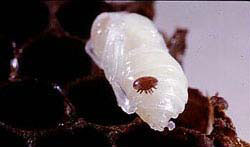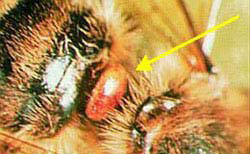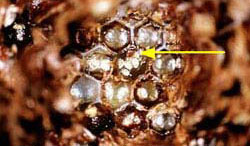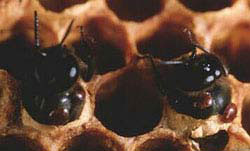Exotic honey bee parasites
If these pests established in Australia – severe losses of bee colonies would occur.
Early detection of these pests in Australia is extremely important to limit their spread and impact on the livelihood beekeepers.
Beekeepers are encouraged to study these pests so they can recognise them.
If you see or suspect an exotic pest or disease is present in your apiary, you must report it immediately by calling the Exotic Plant Pest Hotline on 1800 084 881 (24 hours a day, every day of the year).
It may also be necessary to confirm a field diagnosis using laboratory tests. Seek advice on the correct procedures for this to be done if you are unsure at the time of making your report.
Hive inspection requirements
Beekeepers are encouraged to check their hives for pests and diseases at least every 3 months as part of good beekeeping practises.
But there are also mandatory minimum inspection requirements imposed by the Livestock Disease Control Regulations 2017. Beekeepers are required by law to
- Visually inspect every hive owned by the beekeeper for the presence of pests or disease 2 or more times in any 12-month period with a minimum of 4 months between 2 examinations AND
- Test one hive per apiary kept by the beekeeper for the presence of arthropod pests (e.g. Varroa and Tropilaelaps mites) 2 or more times in any 12-month period with a minimum of 4 months between 2 tests. The testing method that should be used is brood uncapping and then the beekeepers choice of either alcohol wash or sugar shake.
if you normally wear reading glasses, wear them while looking for these mites.
Varroa mite
Varroa mite of honey bees
Find information on the current Agriculture Victoria response to Varroa mite detections.
 The adult female Varroa mite (Varroa destructor) is reddish-brown and shaped like a scallop shell. It is about 1.1 mm long and 1.7 mm broad and can be seen with the naked eye.
The adult female Varroa mite (Varroa destructor) is reddish-brown and shaped like a scallop shell. It is about 1.1 mm long and 1.7 mm broad and can be seen with the naked eye.
The mites spend most of their life inside sealed brood cells where they multiply and feed on developing pupa. In lightly infested colonies this is the most likely place to find them.
Female mites can also be found on adult bees. They often hide between the hardened abdominal segments closest to the thorax. The mites may be found on adult bees in overwintering colonies that have no honey bee brood.
Mite numbers increase slowly within a hive and it may take several years of infestation for mite numbers to be sufficiently high for bee larvae to be parasitised by several females.
 When this occurs, newly emerged adult bees with deformed wings, legs and abdomens may be found at the hive entrance. Patchy brood patterns may also be evident in advanced infestations.
When this occurs, newly emerged adult bees with deformed wings, legs and abdomens may be found at the hive entrance. Patchy brood patterns may also be evident in advanced infestations.
The females of another species, V. jacobsoni, are slightly smaller than females of V. destructor. This species was recently found reproducing on European honey bees in Papua New Guinea. A laboratory diagnosis is necessary to confirm the presence of these mites.
Field diagnosis of Varroa mite

Alcohol wash method
Alcohol washing is a quick and effective method for detecting the presence of Varroa and Tropilaelaps mites, as well as monitoring mite levels in a bee colony. Alcohol washing can remove over 90% (with multiple washes) of external Varroa mites present on adult honey bees.
Alcohol washing involves collecting a sample of approximately 300 (1/2 cup) bees, taken from the centre of the brood nest. Placing the bees in a jar or container they are washed in 125ml of 75% rubbing alcohol or methylated spirits. This wash is performed 3 times in total on the same sample of bees.
For detailed steps on performing an alcohol wash go to our 'Alcohol wash test to detect honey bee parasites' page.
Brood uncapping method - examination of honey bee brood
Varroa prefer drone pupae at the edge of the brood nest. If there are drone pupae, use a pair of tweezers or a hive tool to remove individual pupae from their cells. Worker pupae should be examined if there are no drone pupae present in the hive.
Examine 50 to 100 of these for reddish-brown mites. When removing a pupa, carefully examine inside the brood cell, especially the base, for any mites.
This is important, because Varroa may remain in the cell when brood is removed.

Sugar shake method - icing sugar dusting of adult bees
When Varroa are dusted with icing sugar, the fine granules stick to their pads (feet) and they are no longer able to grip the surface on which they cling. The dusting of adult bees with icing sugar causes mites to fall off the bee into the white sugar where they are more easily seen.
The following simple detection method is now used by many beekeepers throughout Australia:
- Obtain a 500 gram or 750 gram jar with a plastic or metal lid.
- Drill 50 to 70, 3 to 4 mm holes in the lid.
- Place a heaped tablespoon of pure icing sugar into the jar.
- Light a smoker and open a hive in the normal manner.
- Shake some bees from 3 combs of brood onto a double thickness of newspaper or upturned hive lid. If brood is not present, shake bees from one comb taken from the centre of the cluster of bees.
- Scoop or pour about 300 bees (half a cup) into the jar. Place the lid on the jar to prevent bees from escaping.
- Gently rotate the jar for 2 minutes ensuring all bees are dusted with sugar. Wait 2 to 3 minutes, and rotate the jar a second time for 2 minutes. Be careful not to lose any sugar.
- Shake the icing sugar (and any mites) through the holes in the lid into a small container of water (preferably white container). The sugar will dissolve and any mites will float on the surface of the water. Do this shaking in a sheltered position protected from strong wind that could blow mites away.
- Release the bees from the jar onto the ground close to the hive entrance in case the queen is present.
- Examine the empty jar and lid for Varroa. If you wear glasses to read, wear them while looking for Varroa.
- Inspect the water surface for Varroa, other mites and insects. If you find any, carefully tip them into a small jar and place this in a cool position away from sunlight. Alternatively, pour the water through a piece of light coloured fine cloth, or fine close weaved household cleaning cloth, or coffee filter paper. Inspect the cloth or filter paper for Varroa. Place and seal the filter cloth or filter paper in a zip-lock plastic bag or other sealable container.
- Refer to notes below 'Steps if you find or suspect presence of an exotic parasite or pest in your apiary'.
Tropilaelaps mite (Tropilaelaps mecedesae and T. clareae)
This mite (sometimes known as the Asian mite) is a parasite of brood only. It causes death of brood or reduced longevity of adult bees that survive the parasitised brood stage. It will breed and survive in bee colonies as long as brood is present.
The adult female mite is light reddish-brown, with an oval shaped body about 0.96mm in length and 0.55mm in width.

Field diagnosis of Tropilaelaps mite
Initial signs of infestation are:
- an irregular pattern of sealed and unsealed brood
- newly emerged adult bees with deformed wings, legs and abdomens at the hive entrance
- deformed pupal remains also at the hive entrance.
Brood uncapping
Examine 50 to 100 pupa for reddish mites.
Use a pair of tweezers or a hive tool to remove individual pupae from their cells and examine them carefully.
A laboratory diagnosis is necessary to confirm the presence of this mite.
Other pests endemic to Victoria
Pollen mite (Mellitiphis alvearius)
Found naturally in beehives in Australia, it is not a parasite of honey bees.
The mite is:
- brown
- smaller than Varroa
- measures 0.75 × 0.75mm.
A laboratory diagnosis is necessary to confirm the presence of this mite.
Braula fly

Braula are a flattened wingless fly that is often incorrectly called bee louse.
Adult braula are reddish-brown and measure 1.2 to 1.5mm long and 0.75mm wide. They have 6 legs, are visible with the naked eye, and their feet have a number of comb like teeth or claws enabling them to grip fast to the hairs of the bees body. They are found on the head and thorax, and between the thorax and abdomen of adult bees of all castes.
Braula fly is established in Tasmania and following its detection in multiple apiaries across Victoria in 2022, Braula fly is now considered established on mainland Australia.
Due to their similar appearance, Braula fly can be confused with the exotic parasites Varroa (Varroa destructor and V. jacobsoni) and Tropilaelaps mites (Tropilaelaps clareae and T. mercedesae).
Braula fly remains a notifiable pest in Victoria under the Livestock Disease Control Act 1994. You must report Braula fly to the Exotic Plant Pest Hotline 1800 084 881 if detected in Victoria.
Reporting Braula to Agriculture Victoria will help us understand the spread of Braula across Victoria and help prevent the misidentification of Braula leading to the failure to report exotic pests like Varroa and Tropilaelaps mites.
Field diagnosis
Braula may be found on both honey bee workers and queen. They feed on nectar and pollen at the host bee's mouth. Braula larvae are not found on brood combs, but tunnel under the cappings of honey combs producing raised lines which damages the appearance of the comb.
Visual inspection is believed to be the best method to detect Braula fly in hive, by holding a brood frame out in front of you and scanning your eyes over the bees from side to side, looking for Braula on the honey bees.
Alcohol wash and sugar shake methods can be used but there is some evidence that these methods are less effective due to Braula possessing strong clawed feet that grip onto honey bees and stop them from being dislodged into the alcohol or icing sugar.
If you find or suspect the presence of an exotic parasite or pest in your apiary
When an exotic parasite or pest is found or even suspected to be present in an apiary it must not spread to another apiary.
These steps will help to reduce the risk of spreading a parasite or pest:
- Collect a specimen of the parasite or pest and place it in a small jar of methylated spirits. Keep the jar in a cool, safe place away from sunlight. Don't mail or forward any samples until advised by one of our apiary officers. Never take live specimens from the apiary as this may help to spread the parasite or pest.
- Reassemble the opened hive to its normal position.
- Mark the hive with a water proof felt pen (or similar) so it can be easily identified later. Mark the lid and all the boxes of the hive with the same identification number.
- Don't remove bees or any hive components from this apiary as it could help spread any parasite or pest.
- Before leaving the apiary, inspect your vehicle to make sure there are no bees trapped inside or on the radiator. Remove or spray any bees that could be carried from the apiary. Check the tray of the truck, ute or trailer as well. Boxes of combs and other hive material on your vehicle which bees might have entered – must be left at the apiary.
- Thoroughly wash your hands, hive tool, smoker and any other equipment to ensure any parasite or pest is not carried from the apiary.
- Use a fine toothed comb or brush to remove any mites that may have lodged in your hair or beard.
- Place overalls, veil, gloves (and guantlets) and hat in plastic bag and leave at the apiary site until advised by our apiary officers.
- Check clothing for any 'passenger' bees that could be carried by you when leaving the apiary. If another person is with you, have them check your clothing and check theirs for passenger bees.
Notifiable diseases
If you see or suspect that any of these exotic parasites are present in your apiary, you must report it immediately by calling the Exotic Plant Pest Hotline: 1800 084 881 (24 hours a day, every day of the year).
Notification is required by the Livestock Disease Control Act (1994). To not notify is to break the law.
Early reporting and recognition of these parasites is one of the most important factors influencing the chance of controlling them and reducing their economic and social impact on the whole community.
Further information
If you require further information or assistance, please contact the Customer Service Centre on 136 186 or email honeybee.biosecurity@agriculture.vic.gov.au
Photo credits
Figure 1. Varroa on pupa of worker bee. Photo courtesy Denis Anderson, CSIRO Entomology, Canberra
Figure 2. Varroa mite on adult bee. Photo copyright NSW Agriculture
Figure 3. An open honey bee (Apis mellifera) brood cell showing adult Varroa and offspring. Photo courtesy Denis Anderson, CSIRO Entomology, Canberra
Figure 4. Varroa jacobsoni on emerging Eastern honey bee (Apis cerana javana) drones. Photo courtesy Denis Anderson, CSIRO Entomology, Canberra
Figure 5. Tropilaelaps mite (Tropilaelaps clarae). Photo courtesy Ken Walker, Museums Victoria, PADIL.
Figure 6. Braula fly (Braula coeca). Photo courtesy Simon Hinkley & Ken Walker, Museums Victoria, PADIL.
Reporting a honey bee pest or disease
Report any unusual pest or disease of honey bees immediately using our online reporting system or by calling the Exotic Plant Pest Hotline on 1800 084 881. Early reporting increases the chance of effective control and eradication.
Please take multiple good quality photos of the pests or symptoms of disease to include in your report where possible, as this is essential for rapid pest and disease diagnosis and response.
Your report will be responded to by an experienced staff member who may seek more information about the detection and explain next steps.
Report now